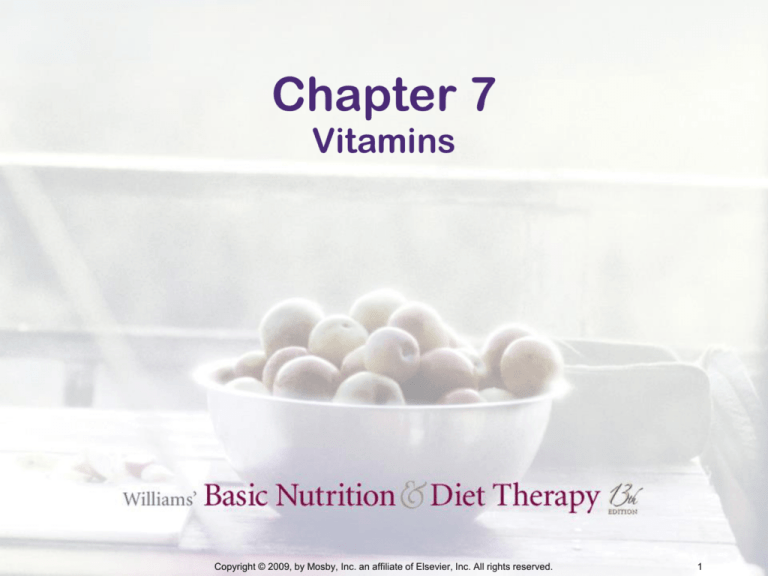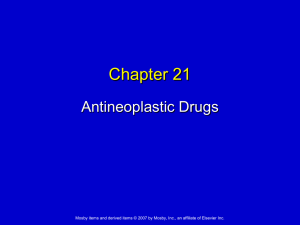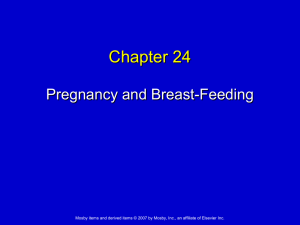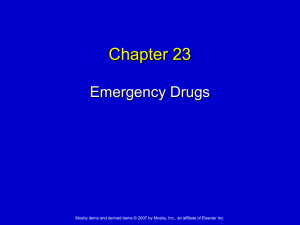
Chapter 7
Vitamins
Copyright © 2009, by Mosby, Inc. an affiliate of Elsevier, Inc. All rights reserved.
1
Chapter 7
Lesson 7.1
Copyright © 2009, by Mosby, Inc. an affiliate of Elsevier, Inc. All rights reserved.
2
Key Concept
• Vitamins are noncaloric essential
nutrients necessary for many
metabolic tasks and the prevention
of associated deficiency diseases.
Copyright © 2009, by Mosby, Inc. an affiliate of Elsevier, Inc. All rights reserved.
3
Dietary Reference Intakes
• Recommendations for nutrient
intake by healthy population groups
• Based on gender and age
–
–
–
–
RDA
EAR
AI
UL
Copyright © 2009, by Mosby, Inc. an affiliate of Elsevier, Inc. All rights reserved.
4
Discovery: Early
Observations
• Discovered while searching for
cures for classic diseases
– Dr. James Lind and scurvy
• Sailors dying on long voyages without fresh
food
• Lemons and limes provided, no one
became ill
• British soldiers got the nickname “limeys”
Copyright © 2009, by Mosby, Inc. an affiliate of Elsevier, Inc. All rights reserved.
5
Discovery: Early Animal
Experiments
• Dr. Frederick Hopkins of Cambridge
University
– Two groups of rats
• Group 1: Fed synthetic mix of protein,
carbohydrate, fat, mineral salts, and water
– All rats died
• Group 2: Fed same ration but with purified
milk
– All rats grew normally
– Proved that accessory factors are present in
natural foods that are essential to life
Copyright © 2009, by Mosby, Inc. an affiliate of Elsevier, Inc. All rights reserved.
6
Era of Vitamin Discovery
• Most vitamins were discovered in
the first half of the 1900s
• At first scientists assigned letters of
the alphabet to each vitamin
– A, C, D, E, K
• This practice was abandoned in
favor of more specific names based
on structure and function
– Cobalamin, pyridoxine, choline
Copyright © 2009, by Mosby, Inc. an affiliate of Elsevier, Inc. All rights reserved.
7
Definition of Vitamin
• It must be a vital, organic substance
that is only necessary in extremely
small amounts.
• It cannot be manufactured by the
body in sufficient quantities to
sustain life, so it must be supplied by
diet.
Copyright © 2009, by Mosby, Inc. an affiliate of Elsevier, Inc. All rights reserved.
8
Function of Vitamins
• Metabolism: Enzymes and
coenzymes
• B vitamins are part of coenzymes
– Coenzymes needed to perform certain
functions, such as:
• Glucose metabolism
• Protein metabolism
• Fatty acid metabolism
Copyright © 2009, by Mosby, Inc. an affiliate of Elsevier, Inc. All rights reserved.
9
Functions of Vitamins, cont’d
• Tissue structure and protection
– Vitamin C
• Prevention of deficiency diseases
– Scurvy
– Beriberi
– Pellagra
Copyright © 2009, by Mosby, Inc. an affiliate of Elsevier, Inc. All rights reserved.
10
Vitamin Metabolism
• Fat soluble
– Vitamins incorporated with absorbed fat and
transported by chylomicrons
– Best absorbed when eaten with fat
– May be stored for long periods
• Water soluble
– Easily absorbed and transported by the portal
circulation
– Not stored, so must be eaten on regular basis
(exceptions: B12 and B6)
Copyright © 2009, by Mosby, Inc. an affiliate of Elsevier, Inc. All rights reserved.
11
Chapter 7
Lesson 7.2
Copyright © 2009, by Mosby, Inc. an affiliate of Elsevier, Inc. All rights reserved.
12
Key Concepts
• Certain health problems are related to
inadequate or excessive vitamin intake.
• Vitamins occur in a wide variety of foods
that are packaged with the energy- and
tissue-building macronutrients
(carbohydrate, fat, and protein). The body
uses vitamins to make coenzymes
required for some enzymes to function.
Copyright © 2009, by Mosby, Inc. an affiliate of Elsevier, Inc. All rights reserved.
13
Fat-Soluble Vitamins:
Vitamin A (Retinol)
• Functions
– Vision
– Tissue strength and immunity
– Growth
• Requirements
– Food forms and units of measure
– Body storage
•
•
•
•
Deficiency disease: Xerophthalmia
Toxicity symptoms
Food sources
Stability
Copyright © 2009, by Mosby, Inc. an affiliate of Elsevier, Inc. All rights reserved.
14
Vitamin D (Cholecalciferol)
• Functions
– Absorption of calcium and phosphorus
– Bone mineralization
• Requirements
• Deficiency disease: Rickets and
osteoporosis
• Toxicity symptoms
• Food sources
• Stability
Copyright © 2009, by Mosby, Inc. an affiliate of Elsevier, Inc. All rights reserved.
15
Child with Rickets
Copyright © 2009, by Mosby, Inc. an affiliate of Elsevier, Inc. All rights reserved.
16
Vitamin E (Tocopherol)
• Functions
– Antioxidant function
– Relation to selenium metabolism
•
•
•
•
•
Requirements
Deficiency disease: Hemolytic anemia
Toxicity symptoms
Food sources
Stability
Copyright © 2009, by Mosby, Inc. an affiliate of Elsevier, Inc. All rights reserved.
17
Vitamin K
• Functions
– Blood clotting
– Bone development
•
•
•
•
•
Requirements
Deficiency disease: Uncommon
Toxicity symptoms
Food sources
Stability
Copyright © 2009, by Mosby, Inc. an affiliate of Elsevier, Inc. All rights reserved.
18
Chapter 7
Lesson 7.3
Copyright © 2009, by Mosby, Inc. an affiliate of Elsevier, Inc. All rights reserved.
19
Key Concepts
• Certain health problems are related to
inadequate or excessive vitamin intake.
• Vitamins occur in a wide variety of foods
that are packaged with the energy- and
tissue-building macronutrients
(carbohydrate, fat, and protein). The body
uses vitamins to make coenzymes
required for some enzymes to function.
Copyright © 2009, by Mosby, Inc. an affiliate of Elsevier, Inc. All rights reserved.
20
Water-Soluble Vitamins:
Vitamin C (Ascorbic Acid)
• Functions
– Connective tissue
– General body metabolism
– Antioxidant function
•
•
•
•
•
Requirements
Deficiency disease: Scurvy
Toxicity symptoms
Food sources
Stability
Copyright © 2009, by Mosby, Inc. an affiliate of Elsevier, Inc. All rights reserved.
21
Thiamin (Vitamin B1)
• Functions
– Gastrointestinal system
– Nervous system
– Cardiovascular system
•
•
•
•
•
Requirements
Deficiency disease: Beriberi
Toxicity symptoms
Food sources
Stability
Copyright © 2009, by Mosby, Inc. an affiliate of Elsevier, Inc. All rights reserved.
22
Riboflavin (Vitamin B2)
• Functions
– Energy production
– Tissue protein building
•
•
•
•
•
Requirements
Deficiency disease
Toxicity symptoms
Food sources
Stability
Copyright © 2009, by Mosby, Inc. an affiliate of Elsevier, Inc. All rights reserved.
23
Niacin (Vitamin B3)
• Functions
– Energy metabolism
– DNA repair
•
•
•
•
•
Requirements
Deficiency disease: Pellagra
Toxicity symptoms
Food sources
Stability
Copyright © 2009, by Mosby, Inc. an affiliate of Elsevier, Inc. All rights reserved.
24
Niacin Deficiency: Pellagra
Copyright © 2009, by Mosby, Inc. an affiliate of Elsevier, Inc. All rights reserved.
25
Vitamin B6 (Pyridoxine)
• Functions
– Protein metabolism
– Neurotransmitter
•
•
•
•
•
Requirements
Deficiency disease
Toxicity symptoms
Food sources
Stability
Copyright © 2009, by Mosby, Inc. an affiliate of Elsevier, Inc. All rights reserved.
26
Folate
• Functions
– Converted to tetrahydrofolate, which aids in:
• DNA synthesis
• Regulation of blood homocysteine levels
• Requirements
• Deficiency diseases: Megaloblastic
anemia, Neural tube defects
• Toxicity symptoms
• Food sources
• Stability
Copyright © 2009, by Mosby, Inc. an affiliate of Elsevier, Inc. All rights reserved.
27
Cobalamin (Vitamin B12)
• Functions
– Regulation of blood homocysteine levels
– Heme synthesis
– Nervous system functioning
•
•
•
•
•
Requirements
Deficiency disease: Pernicious anemia
Toxicity symptoms
Food sources
Stability
Copyright © 2009, by Mosby, Inc. an affiliate of Elsevier, Inc. All rights reserved.
28
Digestion and Absorption of
Vitamin B12
Copyright © 2009, by Mosby, Inc. an affiliate of Elsevier, Inc. All rights reserved.
29
Pantothenic Acid
• Functions
– Acetyl coenzyme A
• Needed to extract energy from all macronutrients
•
•
•
•
•
Requirements
Deficiency disease: Unlikely
Toxicity symptoms
Food sources
Stability
Copyright © 2009, by Mosby, Inc. an affiliate of Elsevier, Inc. All rights reserved.
30
Biotin
• Functions
– Coenzyme for carboxylases
• Requirements
• Deficiency disease: No natural
deficiency known
• Toxicity symptoms
• Food sources
• Stability
Copyright © 2009, by Mosby, Inc. an affiliate of Elsevier, Inc. All rights reserved.
31
Choline
• Data insufficient to determine its essentiality
• Associated with the B-complex vitamins
– Functions
• Structural integrity of cell membranes
• Neurotransmission
–
–
–
–
–
Requirements
Deficiency disease: Liver damage
Toxicity symptoms
Food sources
Stability
Copyright © 2009, by Mosby, Inc. an affiliate of Elsevier, Inc. All rights reserved.
32
Chapter 7
Lesson 7.4
Copyright © 2009, by Mosby, Inc. an affiliate of Elsevier, Inc. All rights reserved.
33
Key Concept
• The need for particular vitamin
supplements depends on a person’s
vitamin status.
Copyright © 2009, by Mosby, Inc. an affiliate of Elsevier, Inc. All rights reserved.
34
Phytochemicals
• Bioactive molecules with health
benefits
• Act as antioxidants or hormones
• Some researchers believe there are
more than 25,000 phytochemicals,
many of which have yet to be
identified.
Copyright © 2009, by Mosby, Inc. an affiliate of Elsevier, Inc. All rights reserved.
35
Phytochemicals, cont’d
• Functions
– Link between intake and chronic diseases
– Synergistic action
• Recommended intake
• Food sources
– Seven colors with corresponding
phytochemical
• Lycopene, zeaxanthin, anthocyanin, beta-carotene,
flavonoids, glucosinolate, allyl sulfides
Copyright © 2009, by Mosby, Inc. an affiliate of Elsevier, Inc. All rights reserved.
36
Vitamin Supplementation
• Ongoing debate
• Biochemical individuality
– Life cycle needs
•
•
•
•
Pregnancy and lactation
Infancy
Children and adolescents
Aging
Copyright © 2009, by Mosby, Inc. an affiliate of Elsevier, Inc. All rights reserved.
37
Vitamin Supplementation,
cont’d
• Lifestyle
•
•
•
•
•
•
Oral contraceptive use
Restricted diets
Exercise programs
Smoking
Alcohol
Caffeine
– Disease
Copyright © 2009, by Mosby, Inc. an affiliate of Elsevier, Inc. All rights reserved.
38
Vitamin Supplementation,
cont’d
• Megadoses
– Toxic effects
– “Artificially induced” deficiencies
• Supplementation principles
• Functional foods
Copyright © 2009, by Mosby, Inc. an affiliate of Elsevier, Inc. All rights reserved.
39
Summary
• Vitamins are food substances
required in very small amounts.
• Body cannot make vitamins, but a
well-balanced and varied diet
usually supplies sufficient intake.
• Fat-soluble vitamins are A, D, E, K.
• Water-soluble vitamins are C and Bcomplex.
Copyright © 2009, by Mosby, Inc. an affiliate of Elsevier, Inc. All rights reserved.
40
Summary, cont’d
• Possibility of toxicity is increased for fatsoluble vitamins compared with watersoluble vitamins.
• Water-soluble vitamins C and pyridoxine
in megadoses can be harmful.
• Phytochemicals are found in whole and
unrefined plant foods.
• Nutrition supplementation is a
controversial subject.
Copyright © 2009, by Mosby, Inc. an affiliate of Elsevier, Inc. All rights reserved.
41






